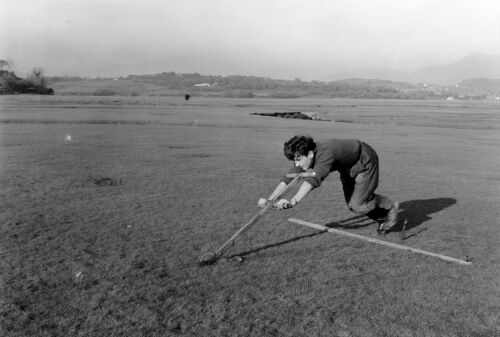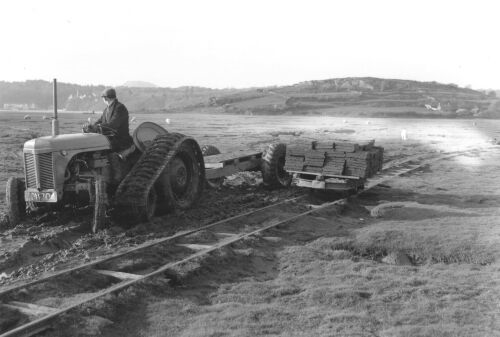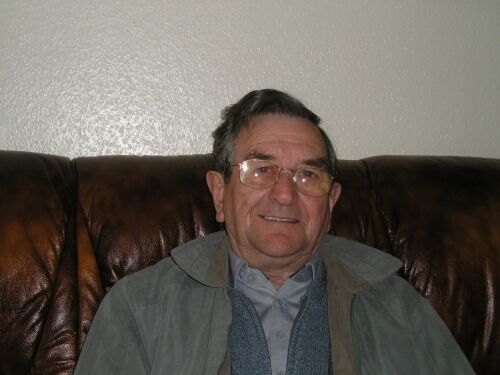For those who know the Talsarnau area, most of the village is located at the bottom of a steep hill. The main street and many other buildings including the school, the community centre etc. are very slightly above sea level and in order to protect the area, a tidal embankment was built as a defence in the nineteenth century.
 About half a mile from the village the river, Afon Dwyryd runs past Ynys Gifftan and Porthmeirion on its way to the sea through what is known as y Traeth Bach. When the tide is not high, there is a large stretch of beach between the tidal bank and the river itself and a large part of it is covered with grass. This is nutritious green land and much of it has been divided and fenced by local farmers. It is said that the meat of the sheep that graze here has a very special taste.
About half a mile from the village the river, Afon Dwyryd runs past Ynys Gifftan and Porthmeirion on its way to the sea through what is known as y Traeth Bach. When the tide is not high, there is a large stretch of beach between the tidal bank and the river itself and a large part of it is covered with grass. This is nutritious green land and much of it has been divided and fenced by local farmers. It is said that the meat of the sheep that graze here has a very special taste.
Years ago, beyond the farthest boundaries of the farms, on land known as Dir Y Goron, an industry developed which helped to put Talsarnau on the map so to speak. An industry indeed that Bob Owen, Croesor would have been delighted to include in his book - The Lost Industries. But it wasn't like that, as the Turf Cutting industry happened after Bob Owen published his book. But now this industry has also ceased for a large number of years. The history of the work has been a relatively short period, that is, between 1953 and 1962, but it was an important industry in its own way in that period. The company he founded on Talsarnau beach was that of Maxwell M. Hart – London Ltd., from Reading in Berkshire, - a company originally from Edinburgh in Scotland.
 Between 1953 and 1962 there was a significant demand for good quality green ground for the purpose of football pitches, tennis greens and bowling greens. It was realized that the land on Talsarnau beach was not fit for purpose and in this period turf was supplied for bowling greens in places such as: Worthing, Acton, Alder Marston, Chester Le Street, Durham, Hoover Factory Merthyr Tydfil; Wandsworth churchyard; Wimbledon tennis greens and Wembley football field plantation and many other places in England.
Between 1953 and 1962 there was a significant demand for good quality green ground for the purpose of football pitches, tennis greens and bowling greens. It was realized that the land on Talsarnau beach was not fit for purpose and in this period turf was supplied for bowling greens in places such as: Worthing, Acton, Alder Marston, Chester Le Street, Durham, Hoover Factory Merthyr Tydfil; Wandsworth churchyard; Wimbledon tennis greens and Wembley football field plantation and many other places in England.
During this short period of less than ten years, many worked there. One called Albert Jackson was the 'foreman' who used to live in "Y Cottage" in the High Street in the village. One who worked there for the whole period and who was so kind as to present this history was Derwyn Evans who now lives in Llandecwyn, about 2 miles from Dalsarnau and has many memories of this period.
Other names who worked there were Wil R, Tanygrisiau; Ben Bowen; Ifan Hughes, Yr Ynys; Gwynogryn Evans – Derwyn's brother; Arwyn Williams – Ali Bwtsh; Billy Thomas, Kilfor; Emrys, Stryd Gefn and Gwynfor Lloyd from Cwm Cynfal. In order to transport the turf to their destination many drove the lorries. The names of some of the drivers include David John Williams, Porthmadog; Jack Morris, Porthmadog; Harri Jones, Blaenau Ffestiniog; Twm Harlech, Blaenau Ffestiniog and Robin Tudur Hughes worked for the lorry company T Glyn Williams and Williams Brothers, Queens Ferry - lorries that carried 16 tonnes at a time. Between them they were responsible for carrying thousands of square yards of turf from Talsarnau beach.

During this short period of less than ten years, many worked there. One called Albert Jackson was the 'foreman' who used to live in "Y Cottage" in the High Street in the village. One who worked there for the whole period and who was so kind as to present this history was Derwyn Evans who now lives in Llandecwyn, about 2 miles from Dalsarnau and has many memories of this period. Other names who worked there were Wil R, Tanygrisiau; Ben Bowen; Ifan Hughes, Yr Ynys; Gwynogryn Evans – Derwyn's brother; Arwyn Williams – Ali Bwtsh; Billy Thomas, Kilfor; Emrys, Stryd Gefn and Gwynfor Lloyd from Cwm Cynfal.
In order to transport the turf to their destination many drove the lorries. The names of some of the drivers include David John Williams, Porthmadog; Jack Morris, Porthmadog; Harri Jones, Blaenau Ffestiniog; Twm Harlech, Blaenau Ffestiniog and Robin Tudur Hughes worked for the lorry company T Glyn Williams and Williams Brothers, Queens Ferry - lorries that carried 16 tonnes at a time. Between them they were responsible for carrying thousands of square yards of turf from Talsarnau beach.


